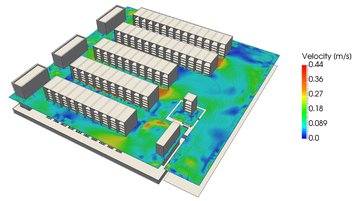A new Frost & Sullivan study estimates investments of up to $432 billion in data centers by 2025. This represents a CAGR of 10 percent, capitalizing on exponential data demands from the Internet of Things (IoT), big data, and artificial intelligence. Growth is global, with the Asia-Pacific region predicted to have the fastest emerging growth in data centers.
Designing and running energy and resource-efficient data centers is essential, with overall design performance making a big impact on returns on investment. Historically, data centers consume significant power for cooling – supplied by expensive chillers and mechanical systems. Recent approaches using natural sources of heat sinks to minimize energy consumption associated with thermal management have been built in cooler climates, and continue to push the boundaries of data center designs.
Mathematical models are your guide
Recent increases in data center efficiency have a direct correlation with technological feats in cloud-based simulation and modeling tools. Simulating a design using mathematical models captures its predicted behavior in an easy-to-use virtual model that engineers can use to test various scenarios and cooling strategies.
The model can then be used to predict real-world performance giving insight into running costs, equipment performance, and overall design quality. Simulation lets designers iterate and validate their work.
Cloud-based simulation platforms combine and utilize tools that consider heat transfer, airflow, and material properties for each component in a data center. Cloud simulation tools allow easy access for engineers, and foster collaboration amongst remote design teams.
A major advantage of using cloud-based modeling tools is the ability to run scenario analyses in parallel, to make informed decisions on many potential design configurations. A particular type of engineering simulation has consistently yielded powerful insight for designers and engineers alike. Computational fluid dynamics (CFD) is a favorite of engineers working on critical infrastructure, because of its physics-based solvers that adopt the most advanced numerical methods in solving complex problems.
Model CFD in 3D
CFD simulates fluid behavior (water, coolants, and air). For example, a 3D model of a data center is used to predict its physical and thermal response under varying simulated climatic conditions. CFD simulates the principal heat transfer processes — conduction, convection, and radiation, and the thermal efficiency of any building or equipment component. Multiple simulations can be performed simultaneously using cloud-based CFD software. This vastly simplifies a large problem domain, which may have hundreds of potential solutions. Parallel runs allow the simulation of all possible design scenarios, simultaneously, freeing up engineers to spend more time on informed decision-making.
The essence of a simulation tool is to predict performance. The more we are able to predict a system's performance, using fast and accurate tools, the more certainty there is in operational and financial metrics such as downtime, return on investment, and payback.






